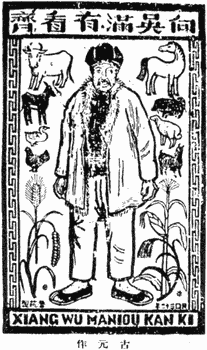 I’ve been reading War and Popular Culture: Resistance in Modern China, 1937–1945, by Chang-tai Hung, which is one of the University of California Press books available for free online. It contains a reproduction of a woodcut with with the following text in romanization:
I’ve been reading War and Popular Culture: Resistance in Modern China, 1937–1945, by Chang-tai Hung, which is one of the University of California Press books available for free online. It contains a reproduction of a woodcut with with the following text in romanization:
XIANG WU MANIOU KAN KI
(齊看有满吴向)
To my disappointment, the book does not discuss the romanization movement at all, though the presence of Sin Wenz (Xīn Wénzì / 新文字) in the woodcut is an indication of its relevence.
Anyway, back to the romanization in the illustration. In Hanyu Pinyin, which would not exist until some 15 years later, XIANG WU MANIOU KAN KI would read “xiàng Wú Mǎnyǒu kànqí” (“emulate Wu Manyou”). This Wu Manyou was a “model peasant” who got his very own official emulate-this-guy campaign in the early 1940s.
Notice that the use of the letter x predates Hanyu Pinyin. (Actually, x in romanization for Sinitic languages long predates Hanyu Pinyin, appearing even in Trigault’s seventeenth-century work.) But even though the xiang of Sin Wenz and the xiang of Hanyu Pinyin are written the same, the two systems handle the letter differently in most cases. In Sin Wenz texts, most of the time the letter x represents what would be written h in Hanyu Pinyin. For example, the full name of Sin Wenz is Latinxua Sin Wenz, not Latinhua Xinwenz. Note, too, the use of the original “Latin” rather than “Ladin”, just as Gwoyeu Romatzyh uses Romatzyh rather than Luomaatzyh, indicating the link between romanization and the alphabet of Rome (Roma).
Also interesting is the form of the character that is second from the right. (These Chinese characters are read from right to left. Put left to right, they would appear as 向吴满有看齊.) Note how it is not in the traditional form:
吳
Nor is it the standard “simplified” form (which would not have been officially adopted for more than decade after this woodblock was made):
吴
Of variant characters there is no end.

What should be setting off alarms in your head is what variety of Chinese uses KI for “齊”?. Sure, if it were 其 etc., no problem, but 齊?
“Ki” in Sin Wenz is [tɕʰi], same as Hanyu Pinyin’s “qi”. Sin Wenz used “k” for both [kʰ] and [tɕʰ] (and “g” for [k] and [tɕ]).
I get it, they saved on initials, by making K do double duty, e.g., Ki
and Kang, just like we save on finals, by making U do double duty,
e.g., Bu and Ju. OK, case closed.